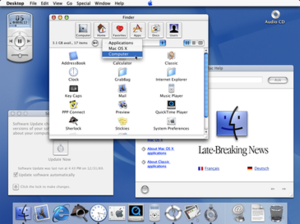Mac OS X Public Beta
| Version of the macOS operating system | |
 | |
| Developer | Apple Computer |
|---|---|
| OS family |
|
| Working state | Historic, not supported |
| Released to manufacturing | September 13, 2000 |
| Platforms | PowerPC |
| Kernel type | Hybrid (XNU) |
| Default user interface | Aqua |
| Preceded by | Mac OS 9 Mac OS X Server 1.0 |
| Succeeded by | Mac OS X 10.0 Cheetah |
| Official website | Apple - Mac OS X at the Wayback Machine (archived November 9, 2000) |
| Support status | |
| Historic, unsupported as of March 24, 2001. Expired on May 14, 2001. | |
| Part of a series on |
| macOS |
|---|
Mac OS X Public Beta (internally
Successor OS
The Public Beta succeeded
Technical changes
The beta's arrival marked some fundamental technical changes, most courtesy of an
Native software
The Public Beta included many of the standard programs bundled with macOS for decades to come, such as
Native
apps that provided a graphical interface to a command-line Unix program.The poor state of the Carbon API contrasted with the relative maturity of Cocoa gave rise to an anti-Carbon bias among Mac OS X users.[9][10]
Expiration
The Mac OS X Public Beta was expired on May 14, 2001; approximately two months after the release of
The expiration date forced users to purchase a copy of the final release rather than continuing to use the Public Beta, as well as reassured industry observers skeptical after the Copland and Rhapsody failures that Apple would actually release a next-generation operating system this time. Owners of the Public Beta version were entitled to a $30 discount on the price of the first full version of Mac OS X 10.0.[12] Only the Aqua GUI and related components of the Public Beta were subject to expiry; the underlying Darwin command-line based OS continued to function.[13]
References
- ^ Marcin Wichary. "GUIdebook > Screenshots > Mac OS X Public Beta". Guidebookgallery.org. Archived from the original on December 19, 2016. Retrieved June 21, 2011.
- ^ "MacWorld Expo San Francisco 2001 - Page 5 - (01/2001)". Archived from the original on July 2, 2014. Retrieved April 17, 2014.
- ^ "MACWORLD Expo - Live Coverage Of Steve Jobs Keynote". The Mac Observer. Archived from the original on July 18, 2011. Retrieved June 21, 2011.
- ^ Edwards, Benj (September 13, 2010). "OS X then and now: What's changed since the beta". Macworld. Archived from the original on November 1, 2012. Retrieved September 19, 2012.
- ^ Singh, Amit (December 2003). "What is Mac OS X?". Archived from the original on May 14, 2012. Retrieved September 26, 2012.
One relatively common notion about Mac OS X seems to be that there's not a lot of software for it. While it is true that the quantity of software available for Mac OS X is not as large as, say, that on Windows or Linux...
- ^ "Best Mac OS X 10.0, 10.1, 10.2, and 10.3 Prices". Archived from the original on October 15, 2012. Retrieved September 26, 2012.
- ^ Siracusa, John (April 2001). "Mac OS X 10.0". Ars Technica. p. 17. Archived from the original on August 17, 2016. Retrieved September 26, 2012.
- ^ "Mac's new OS: Seven years in the making". CNET. March 21, 2001. Archived from the original on November 8, 2010.
The first applications will appear this spring; many more are targeted for later months.
- ^ "Carbon vs Cocoa arguments". Archived from the original on May 11, 2013. Retrieved September 21, 2012.
- ^ Siracusa, John (April 2001). "Mac OS X 10.0". Ars Technica. p. 16. Archived from the original on January 7, 2013. Retrieved September 26, 2012.
The general consensus is that Cocoa applications are superior to Carbon applications in terms of support for OS X features, multitasking ability, and interface responsiveness. Whether this is due to any inherent superiority of the technologies in Cocoa or is merely a byproduct of the immaturity of the Carbon impelmentation (as compared to Cocoa/OpenStep, which has been around for years) is still open for debate
- ^ "Mac OS X Public Beta Expires Today". Archived from the original on January 15, 2015. Retrieved March 4, 2015.
- ^ Edwards, Benj (September 13, 2010). "Looking back at OS X's origins". Macworld. Archived from the original on November 18, 2012. Retrieved September 29, 2011.
- ^ "Analysis unknown Mac OS Public Beta system". Archived from the original on September 12, 2014. Retrieved September 12, 2014.
